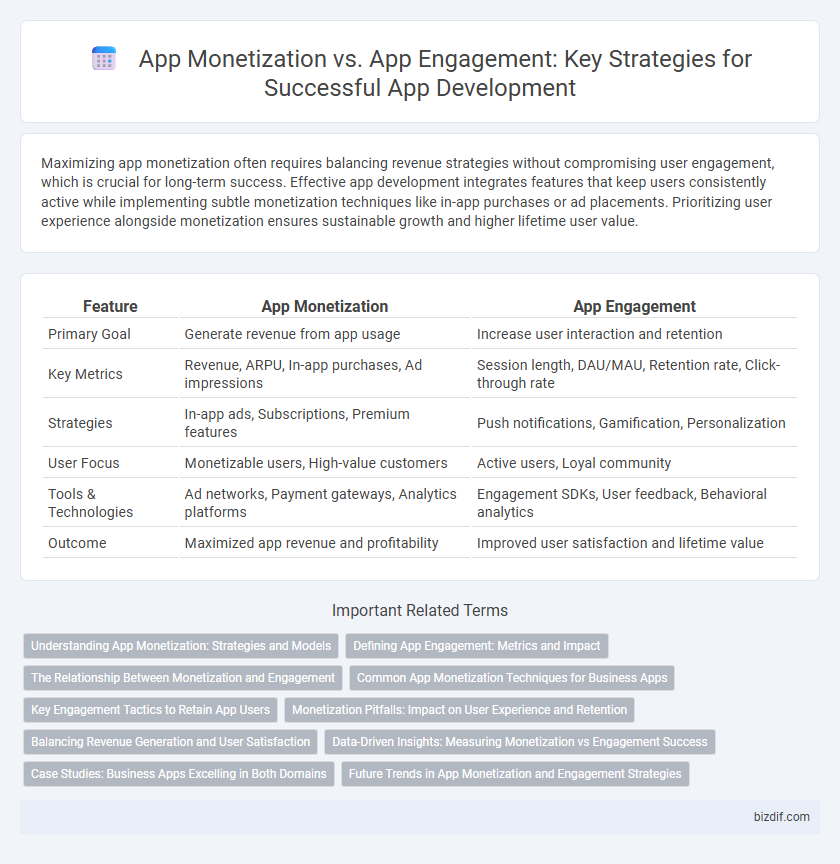Maximizing app monetization often requires balancing revenue strategies without compromising user engagement, which is crucial for long-term success. Effective app development integrates features that keep users consistently active while implementing subtle monetization techniques like in-app purchases or ad placements. Prioritizing user experience alongside monetization ensures sustainable growth and higher lifetime user value.
Table of Comparison
| Feature | App Monetization | App Engagement |
|---|---|---|
| Primary Goal | Generate revenue from app usage | Increase user interaction and retention |
| Key Metrics | Revenue, ARPU, In-app purchases, Ad impressions | Session length, DAU/MAU, Retention rate, Click-through rate |
| Strategies | In-app ads, Subscriptions, Premium features | Push notifications, Gamification, Personalization |
| User Focus | Monetizable users, High-value customers | Active users, Loyal community |
| Tools & Technologies | Ad networks, Payment gateways, Analytics platforms | Engagement SDKs, User feedback, Behavioral analytics |
| Outcome | Maximized app revenue and profitability | Improved user satisfaction and lifetime value |
Understanding App Monetization: Strategies and Models
App monetization involves implementing strategies such as in-app purchases, subscription models, and ad-based revenue to generate income from mobile applications. Understanding user behavior and preferences allows developers to optimize these models for increased profitability while maintaining a positive user experience. Effective monetization balances revenue generation with app engagement to sustain long-term user retention and growth.
Defining App Engagement: Metrics and Impact
App engagement measures user interaction within an app through key metrics such as daily active users (DAU), session length, retention rate, and screen flow analysis. These engagement metrics indicate how effectively an app retains users and drives in-app activity, which directly influences monetization potential by increasing opportunities for in-app purchases and ad impressions. Understanding app engagement helps developers optimize user experience and tailor features that boost long-term app profitability.
The Relationship Between Monetization and Engagement
App monetization and app engagement are intrinsically linked, as higher user engagement typically leads to increased revenue opportunities through in-app purchases, ads, and subscriptions. Effective engagement strategies such as personalized content, push notifications, and gamification enhance user retention, directly boosting the app's monetization potential. Balancing user experience with monetization tactics ensures sustained growth and maximizes lifetime value (LTV) of the app users.
Common App Monetization Techniques for Business Apps
Common app monetization techniques for business apps include in-app purchases, subscription models, and targeted advertising, each designed to generate revenue without compromising user experience. Subscription models offer recurring income through premium features, while in-app purchases enable users to buy additional services or content, enhancing app value. Integrating non-intrusive targeted ads can boost earnings while maintaining user engagement and retention rates.
Key Engagement Tactics to Retain App Users
Key engagement tactics to retain app users include personalized push notifications, in-app rewards, and seamless user onboarding experiences. Leveraging user data to deliver relevant content increases session duration and reduces churn rates significantly. Implementing interactive features such as gamification and social sharing further boosts active user retention and long-term engagement.
Monetization Pitfalls: Impact on User Experience and Retention
Excessive app monetization strategies such as intrusive ads, aggressive in-app purchases, and paywalls can significantly degrade user experience by disrupting seamless navigation and increasing frustration. Poorly balanced monetization often leads to higher user churn rates and lower retention, as users prioritize apps that offer value without constant commercialization. Effective app development requires optimizing monetization methods to enhance revenue without compromising engagement or long-term user loyalty.
Balancing Revenue Generation and User Satisfaction
Maximizing app monetization requires integrating revenue streams such as in-app purchases, ads, and subscriptions without compromising user engagement metrics like session duration and retention rates. Striking a balance ensures sustained user satisfaction while optimizing lifetime value (LTV) and average revenue per user (ARPU). Data-driven strategies leveraging A/B testing help refine monetization features to align with user preferences and reduce churn.
Data-Driven Insights: Measuring Monetization vs Engagement Success
Data-driven insights leverage user behavior analytics and revenue metrics to balance app monetization and engagement strategies effectively. Key performance indicators such as lifetime value (LTV), retention rate, and in-app purchase frequency provide a comprehensive view of financial success and user interaction quality. Applying machine learning models to these datasets enables precise targeting and personalization, optimizing both revenue generation and sustained user engagement.
Case Studies: Business Apps Excelling in Both Domains
Case studies of business apps like Slack and Zoom reveal successful strategies that balance app monetization and user engagement by integrating subscription models with seamless user experiences. These apps leverage in-app analytics to optimize features that drive both revenue and sustained engagement, resulting in increased customer retention and lifetime value. Data shows that combining personalized in-app prompts with premium feature access significantly boosts both monetization metrics and user activity rates.
Future Trends in App Monetization and Engagement Strategies
Future trends in app monetization emphasize personalized experiences and AI-driven analytics to optimize in-app purchases and ad placements, enhancing user value. Engagement strategies increasingly leverage gamification, social integration, and real-time feedback loops to sustain active user bases and deepen app loyalty. Combining advanced data insights with immersive content delivery shapes the evolving landscape of sustained app profitability and user retention.
App Monetization vs App Engagement Infographic

 bizdif.com
bizdif.com